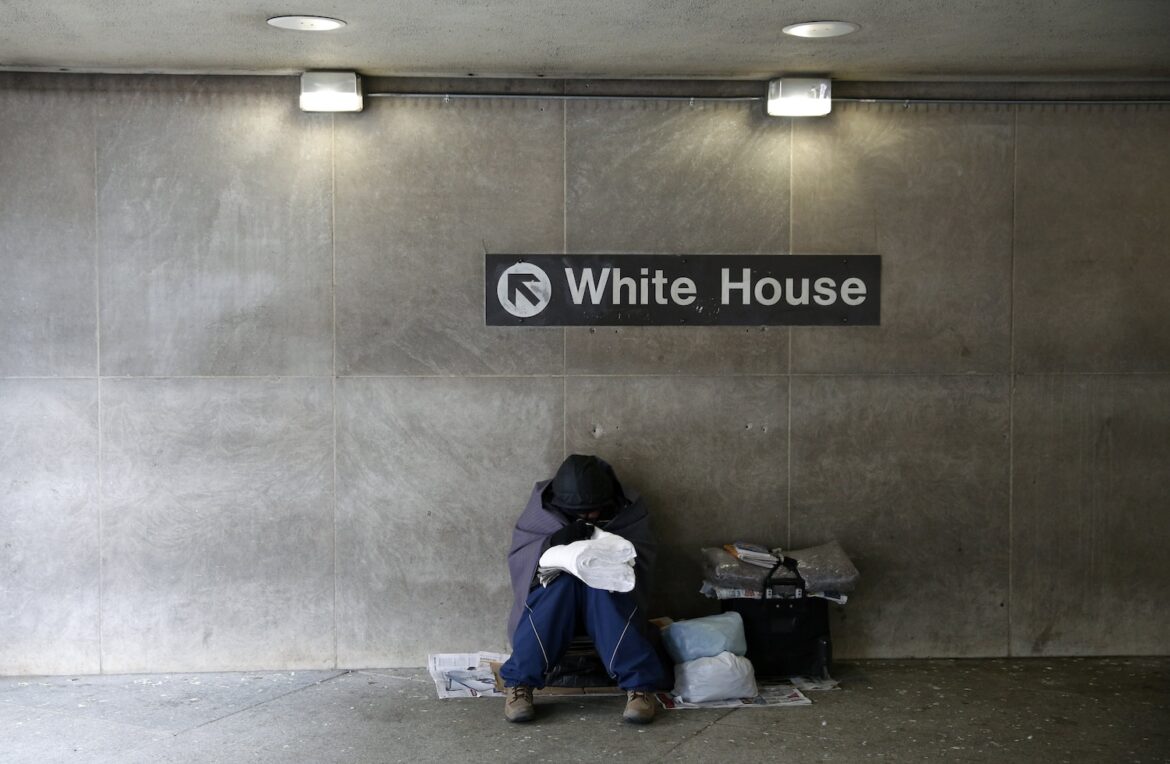(OSV News) — The question was shouted at President Donald Trump as the commander in chief, headed for Scotland, was ready to depart the South Lawn on July 25.
“Mr. President, when I walked to the White House today, I saw homeless people sleeping right outside the gates of the White House,” EWTN correspondent Owen Jensen informed Trump. “Are you concerned about that, sir?”
“I think it’s terrible — and we’ll have them removed immediately,” Trump responded.
The streets of the nation’s capital are home to approximately 5,138 unhoused people, according to the Metropolitan Washington Council of Governments. Their tent camps dot sidewalks, green spaces and underpasses around the city.
In July 2019, during his first presidential term, Trump declared that an embarrassment: “When we have leaders of the world coming in to see the president of the United States and they’re riding down a highway, they can’t be looking at that.”
Executive order
On July 24 of this year, Trump signed a new executive order, “Ending Crime and Disorder on America’s Streets.” And while that sounds like a worthy goal, advocates say blaming the homeless unfairly and dangerously criminalizes being unhoused, mentally ill or addicted in America.
“We are still analyzing the executive order,” Chieko Noguchi, executive director of the Office of Public Affairs at the U.S. Conference of Catholic Bishops, told OSV News. “Our Catholic social teaching affirms that the right to shelter is a basic human right; that sheltering the homeless is a corporal work of mercy.”
The 2024 Annual Homelessness Assessment Report to Congress indicated the total number of Americans experiencing homelessness in 2024 was approximately 771,480 — an 18% increase over 2023, and the highest level recorded.
The National Alliance to End Homelessness, or NAEH, estimated 19,000 people per week became homeless for the first time during 2023. Housing prices are a critical challenge nationwide; 7.3 million affordable housing units are needed for extremely low-income renters.
“I think the order speaks to a particular kind of crisis,” suggested Brian Kelly, professor and director of the doctoral program at Loyola University Chicago’s School of Social Work. “It describes the prevalence of homelessness, and it also describes the prevalence of substance use, mental illness and mental health issues within the population.”
The executive order states, “Shifting homeless individuals into long-term institutional settings for humane treatment through the appropriate use of civil commitment will restore public order.”
It also seeks to “restore” civil commitment, directing the U.S. attorney general to reverse “Federal or State judicial precedents and the termination of consent decrees that impede the United States’ policy of encouraging civil commitment of individuals with mental illness who pose risks to themselves or the public or are living on the streets and cannot care for themselves in appropriate facilities for appropriate periods of time.” Assistance is promised to state and local governments to implement it.
Vagrancy will be addressed through prohibitions on open illicit drug use, camping, loitering and urban squatting.
“It seems to be leaning into uncited science or perspectives about the failure of harm reduction and the failure of Housing First,” observed Kelly, who spent years working with Chicagoans experiencing homelessness. “It seems to be falling back into a regressive perspective that was more or less — both anecdotally and scientifically — proven to be ineffective in terms of really helping people, which is civil commitment.”
Civil commitment legally allows involuntary hospitalization of people with severe mental health issues, if it is determined they pose a danger to themselves or others.
Housing first approach
Neither harm reduction or Housing First programs require participants to first end drug use or first be treated or institutionalized for mental health issues before getting housing. The approach is, according to the NAEH, “guided by the belief that people need basic necessities like food and a place to live before” before dealing with other issues, such as getting a job, budgeting properly or addressing substance use.
The National Institute on Drug Abuse states, “Decades of research have shown that some harm reduction strategies provide significant individual and public health benefits, including preventing deaths from overdoses and preventing transmission of infectious diseases among people who use drugs and the larger community.”
A report from the National Low Income Housing Coalition notes, “Evidence from a systematic review of 26 studies indicates that Housing First programs decreased homelessness by 88% and improved housing stability by 41%, compared to Treatment First programs.”
Kelly said the executive order appears to be “doing away with any kind of harm reduction or Housing First. It seems,” he added, “like we’re moving backwards. … It’s going to start to seem like it’s illegal to be homeless.”
The order says that federal resources are to be redirected “toward effective methods of addressing homelessness,” excluding “harm reduction” programs. There is mention of “public programs” and “private housing support networks” following civil commitment and evaluation, but the order also ends support for “housing first” policies.
Recipients of federal assistance face increased requirements “that persons participating in the recipients’ programs who suffer from substance use disorder or serious mental illness use substance abuse treatment or mental health services as a condition of participation.”
“This is one of the worst actions to impact folks living outside in decades,” asserted Jesse Rabinowitz, campaign and communications director for the National Homelessness Law Center, or NHLC. “It is a violation of people’s civil liberties, and,” he added, “it’s going to make homelessness worse.”
Rabinowitz agreed with Kelly’s assessment.
“This executive order paves the way to arrest or jail folks for being poor, for being sick, for being disabled — and it doesn’t help anybody,” he said. “It doesn’t address the leading cause of homelessness, which is rents that are too high. All it does is punish people.”
Legal action
The NHLC has, Rabinowitz said, taken action.
“We’re working with brilliant attorneys all across the country, trying to figure out how to challenge this in court.”
In 2024, Archbishop Borys A. Gudziak of the Ukrainian Catholic Archeparchy of Philadelphia, chairman of the USCCB’s Committee on Domestic Justice and Human Development, said: “Policies that criminalize homelessness are a direct contradiction of our call to shelter those experiencing homelessness.”
Kevin Brennan, vice president for media relations and executive communications at Catholic Charities USA, told OSV News, “Our government relations team is reviewing the details of the order, and will respond via the rulemaking process.”
Catholic Charities of the Archdiocese of New York and Catholic Charities of the Archdiocese of Los Angeles — agencies operating in cities with two of the largest U.S. homeless populations — declined comment for this article.
“I think a lot of people do wonder — seeing rising homelessness around them — what are things we can do that are positive; that are going to make a difference?” said David Phillips, director of research at the University of Notre Dame’s Lab for Economic Opportunities. “Is this executive order likely to shift toward or away from those things?”
Phillips explained there are a variety of approaches.
“In the United States, there are many different models to respond to homelessness,” he said.
“When people are required to participate in other services alongside housing assistance, there are some who are not at the point where they’re ready for that — and they end up not getting housing assistance, and then they end up back up on the street,” noted Phillips. “And so our goal is to get people into housing — unconditional housing is a way that’s proven effective.”
The U.S. Department of Veteran Affairs echoes Phillips’ assertion.
“The core principles of Housing First,” the VA website states, “have been critical components of VA’s broader homelessness assistance programs since it became VA’s official policy in 2012. … Since 2010, Veteran homelessness has decreased by over 52%, and 83 communities and three states have effectively ended homelessness.”
“It was initially tested on a small scale with a sort of effectiveness trial — could this work?” Phillips said. “It turned out it worked really well.”
A Catholic response
Michael J. Acaldo, CEO of the Society of St. Vincent de Paul USA, is uncompromising in his assessment.
“The streets are not a housing solution,” Acaldo emphasized. “The streets are not a solution for people that need mental health treatment, and it’s not a solution for people that are in need of substance abuse treatment.”
The organization’s website estimates it “costs an average of $35,578 per year to support a person who is chronically homeless, including costs for emergency shelters, healthcare, and law enforcement. In contrast, preventing homelessness permanently through early intervention costs, on average, $2,000.”
Its methods — which mobilized $60 million in 2023 emergency financial assistance to prevent evictions — are diametrically opposed to a sweeping, one-size-fits-all tactic.
“What we strongly believe in at the society is that it’s a one-person approach,” explained Acaldo. “Whether we are knocking on somebody’s door to prevent the homelessness — or someone’s knocking on our St. Vincent de Paul doors that is experiencing it — we can make a difference in their lives, and,” he added, “address those causes of homelessness in a Catholic way that really focuses on the individuality of each person.”
Kimberley Heatherington writes for OSV News from Virginia.




